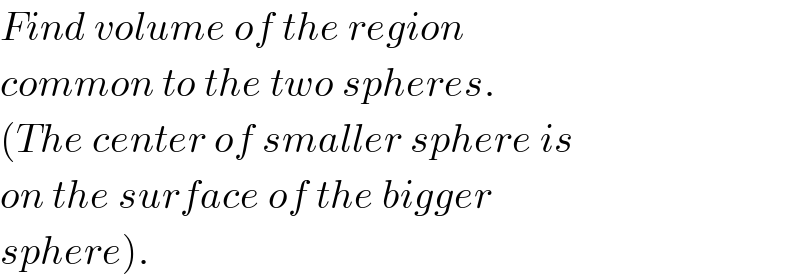
Question Number 37517 by ajfour last updated on 14/Jun/18

Commented by ajfour last updated on 14/Jun/18

$${Find}\:{volume}\:{of}\:{the}\:{region}\: \\ $$$${common}\:{to}\:{the}\:{two}\:{spheres}. \\ $$$$\left({The}\:{center}\:{of}\:{smaller}\:{sphere}\:{is}\right. \\ $$$${on}\:{the}\:{surface}\:{of}\:{the}\:{bigger} \\ $$$$\left.{sphere}\right). \\ $$
Commented by MrW3 last updated on 14/Jun/18
![r^2 −h_1 ^2 =R^2 −(R−h_1 )^2 r^2 −h_1 ^2 =R^2 −R^2 +2Rh_1 −h_1 ^2 r^2 =2Rh_1 ⇒h_1 =(r^2 /(2R)) ⇒h_2 =r−h_1 =r−(r^2 /(2R)) cap 1: V_1 =πh_1 ^2 (R−(h_1 /3))=((πr^4 )/(4R))(1−(r^2 /(6R^2 ))) cap 2: V_2 =πh_2 ^2 (r−(h_2 /3))=((2πr^3 )/3)(1−(r/(2R)))^2 (1+(r/(4R))) ⇒V=πr^3 [(r/(4R))(1−(r^2 /(6R^2 )))+(2/3)(1−(r/(2R)))^2 (1+(r/(4R)))]](Q37519.png)
$${r}^{\mathrm{2}} −{h}_{\mathrm{1}} ^{\mathrm{2}} ={R}^{\mathrm{2}} −\left({R}−{h}_{\mathrm{1}} \right)^{\mathrm{2}} \\ $$$${r}^{\mathrm{2}} −{h}_{\mathrm{1}} ^{\mathrm{2}} ={R}^{\mathrm{2}} −{R}^{\mathrm{2}} +\mathrm{2}{Rh}_{\mathrm{1}} −{h}_{\mathrm{1}} ^{\mathrm{2}} \\ $$$${r}^{\mathrm{2}} =\mathrm{2}{Rh}_{\mathrm{1}} \\ $$$$\Rightarrow{h}_{\mathrm{1}} =\frac{{r}^{\mathrm{2}} }{\mathrm{2}{R}} \\ $$$$\Rightarrow{h}_{\mathrm{2}} ={r}−{h}_{\mathrm{1}} ={r}−\frac{{r}^{\mathrm{2}} }{\mathrm{2}{R}} \\ $$$${cap}\:\mathrm{1}:\:{V}_{\mathrm{1}} =\pi{h}_{\mathrm{1}} ^{\mathrm{2}} \left({R}−\frac{{h}_{\mathrm{1}} }{\mathrm{3}}\right)=\frac{\pi{r}^{\mathrm{4}} }{\mathrm{4}{R}}\left(\mathrm{1}−\frac{{r}^{\mathrm{2}} }{\mathrm{6}{R}^{\mathrm{2}} }\right) \\ $$$${cap}\:\mathrm{2}:\:{V}_{\mathrm{2}} =\pi{h}_{\mathrm{2}} ^{\mathrm{2}} \left({r}−\frac{{h}_{\mathrm{2}} }{\mathrm{3}}\right)=\frac{\mathrm{2}\pi{r}^{\mathrm{3}} }{\mathrm{3}}\left(\mathrm{1}−\frac{{r}}{\mathrm{2}{R}}\right)^{\mathrm{2}} \left(\mathrm{1}+\frac{{r}}{\mathrm{4}{R}}\right) \\ $$$$\Rightarrow{V}=\pi{r}^{\mathrm{3}} \left[\frac{{r}}{\mathrm{4}{R}}\left(\mathrm{1}−\frac{{r}^{\mathrm{2}} }{\mathrm{6}{R}^{\mathrm{2}} }\right)+\frac{\mathrm{2}}{\mathrm{3}}\left(\mathrm{1}−\frac{{r}}{\mathrm{2}{R}}\right)^{\mathrm{2}} \left(\mathrm{1}+\frac{{r}}{\mathrm{4}{R}}\right)\right] \\ $$
Commented by ajfour last updated on 14/Jun/18

$${very}\:{brilliant}\:{Sir}!\: \\ $$$${whats}\:{the}\:{concept}\:{of}\:{the}\: \\ $$$${formula}\:{for}\:{cap}\:{volumes}? \\ $$
Commented by MrW3 last updated on 14/Jun/18

Commented by MrW3 last updated on 14/Jun/18

Answered by ajfour last updated on 14/Jun/18
![let center of larger sphere be origin and z axis vertically upwards. eq. of larger sphere x^2 +y^2 +z^2 =R^2 eq. of smaller sphere x^2 +y^2 +(z−R)^2 =r^2 If radius of circle of intersection be ρ_0 , z_(common) =(√(R^2 −ρ_0 ^2 )) =R−(√(r^2 −ρ_0 ^2 )) ⇒ R^2 −ρ_0 ^2 =R^2 +r^2 −ρ_0 ^2 −2R(√(r^2 −ρ_0 ^2 )) ⇒ (√(r^2 −ρ_0 ^2 ))= (r^2 /(2R)) ...(i) and (√(R^2 −ρ_0 ^2 )) =R−(r^2 /(2R)) ...(ii) ρ_0 ^2 = r^2 −(r^4 /(4R^2 )) ...(iii) dV=(z_l −z_s )ρdρdθ ρ =(√(x^2 +y^2 )) ∫_0 ^( V_(common) ) dV =2π∫_0 ^( ρ_0 ) ((√(R^2 −ρ^2 ))−R+(√(r^2 −ρ^2 )) )ρdρ let s=ρ^2 V_(common) =π∫_0 ^( ρ_0 ^2 ) ((√(R^2 −s)) −R+(√(r^2 −s)) )ds =π{−ρ_0 ^2 R−(2/3)[(R^2 −ρ_0 ^2 )^(3/2) −R^3 ] −(2/3)[(r^2 −ρ_0 ^2 )^(3/2) −r^3 ]} using (i), (ii), (iii) V=π{−r^2 R+(r^4 /(4R))−(2/3)(R−(r^2 /(2R)))^3 +(2/3)R^3 −(2/3)((r^2 /(2R)))^3 +(2/3)r^3 } .](Q37521.png)
$${let}\:{center}\:{of}\:{larger}\:{sphere}\:{be} \\ $$$${origin}\:{and}\:{z}\:{axis}\:{vertically} \\ $$$${upwards}. \\ $$$${eq}.\:{of}\:{larger}\:{sphere} \\ $$$$\:\:{x}^{\mathrm{2}} +{y}^{\mathrm{2}} +{z}^{\mathrm{2}} ={R}^{\mathrm{2}} \\ $$$${eq}.\:{of}\:{smaller}\:{sphere} \\ $$$$\:\:\:{x}^{\mathrm{2}} +{y}^{\mathrm{2}} +\left({z}−{R}\right)^{\mathrm{2}} ={r}^{\mathrm{2}} \\ $$$${If}\:{radius}\:{of}\:\:{circle}\:{of}\:{intersection} \\ $$$${be}\:\rho_{\mathrm{0}} , \\ $$$$\:\:\:\:{z}_{{common}} =\sqrt{{R}^{\mathrm{2}} −\rho_{\mathrm{0}} ^{\mathrm{2}} }\:={R}−\sqrt{{r}^{\mathrm{2}} −\rho_{\mathrm{0}} ^{\mathrm{2}} }\: \\ $$$$\Rightarrow\:{R}^{\mathrm{2}} −\rho_{\mathrm{0}} ^{\mathrm{2}} ={R}^{\mathrm{2}} +{r}^{\mathrm{2}} −\rho_{\mathrm{0}} ^{\mathrm{2}} −\mathrm{2}{R}\sqrt{{r}^{\mathrm{2}} −\rho_{\mathrm{0}} ^{\mathrm{2}} } \\ $$$$\Rightarrow\:\sqrt{{r}^{\mathrm{2}} −\rho_{\mathrm{0}} ^{\mathrm{2}} \:}=\:\frac{{r}^{\mathrm{2}} }{\mathrm{2}{R}}\:\:\:\:...\left({i}\right) \\ $$$${and}\:\:\:\:\:\:\sqrt{{R}^{\mathrm{2}} −\rho_{\mathrm{0}} ^{\mathrm{2}} }\:={R}−\frac{{r}^{\mathrm{2}} }{\mathrm{2}{R}}\:\:\:\:...\left({ii}\right) \\ $$$$\:\:\:\:\:\:\:\rho_{\mathrm{0}} ^{\mathrm{2}} \:=\:{r}^{\mathrm{2}} −\frac{{r}^{\mathrm{4}} }{\mathrm{4}{R}^{\mathrm{2}} }\:\:\:\:\:\:\:\:...\left({iii}\right) \\ $$$${dV}=\left({z}_{{l}} −{z}_{{s}} \right)\rho{d}\rho{d}\theta \\ $$$$\:\:\:\:\:\rho\:=\sqrt{{x}^{\mathrm{2}} +{y}^{\mathrm{2}} } \\ $$$$\int_{\mathrm{0}} ^{\:\:{V}_{{common}} } {dV}\:=\mathrm{2}\pi\int_{\mathrm{0}} ^{\:\:\rho_{\mathrm{0}} } \left(\sqrt{{R}^{\mathrm{2}} −\rho^{\mathrm{2}} }−{R}+\sqrt{{r}^{\mathrm{2}} −\rho^{\mathrm{2}} }\:\right)\rho{d}\rho \\ $$$${let}\:\:\:{s}=\rho^{\mathrm{2}} \\ $$$$\:{V}_{{common}} =\pi\int_{\mathrm{0}} ^{\:\:\rho_{\mathrm{0}} ^{\mathrm{2}} } \left(\sqrt{{R}^{\mathrm{2}} −{s}}\:−{R}+\sqrt{{r}^{\mathrm{2}} −{s}}\:\right){ds} \\ $$$$\:=\pi\left\{−\rho_{\mathrm{0}} ^{\mathrm{2}} {R}−\frac{\mathrm{2}}{\mathrm{3}}\left[\left({R}^{\mathrm{2}} −\rho_{\mathrm{0}} ^{\mathrm{2}} \right)^{\mathrm{3}/\mathrm{2}} −{R}^{\mathrm{3}} \right]\right. \\ $$$$\left.\:\:\:\:\:\:\:\:\:\:\:\:\:\:\:\:\:−\frac{\mathrm{2}}{\mathrm{3}}\left[\left({r}^{\mathrm{2}} −\rho_{\mathrm{0}} ^{\mathrm{2}} \right)^{\mathrm{3}/\mathrm{2}} −{r}^{\mathrm{3}} \right]\right\}\: \\ $$$${using}\:\:\left({i}\right),\:\left({ii}\right),\:\left({iii}\right) \\ $$$${V}=\pi\left\{−{r}^{\mathrm{2}} {R}+\frac{{r}^{\mathrm{4}} }{\mathrm{4}{R}}−\frac{\mathrm{2}}{\mathrm{3}}\left({R}−\frac{{r}^{\mathrm{2}} }{\mathrm{2}{R}}\right)^{\mathrm{3}} \right. \\ $$$$\left.\:\:\:\:\:\:\:\:\:\:\:\:\:+\frac{\mathrm{2}}{\mathrm{3}}{R}^{\mathrm{3}} −\frac{\mathrm{2}}{\mathrm{3}}\left(\frac{{r}^{\mathrm{2}} }{\mathrm{2}{R}}\right)^{\mathrm{3}} +\frac{\mathrm{2}}{\mathrm{3}}{r}^{\mathrm{3}} \right\}\:. \\ $$
